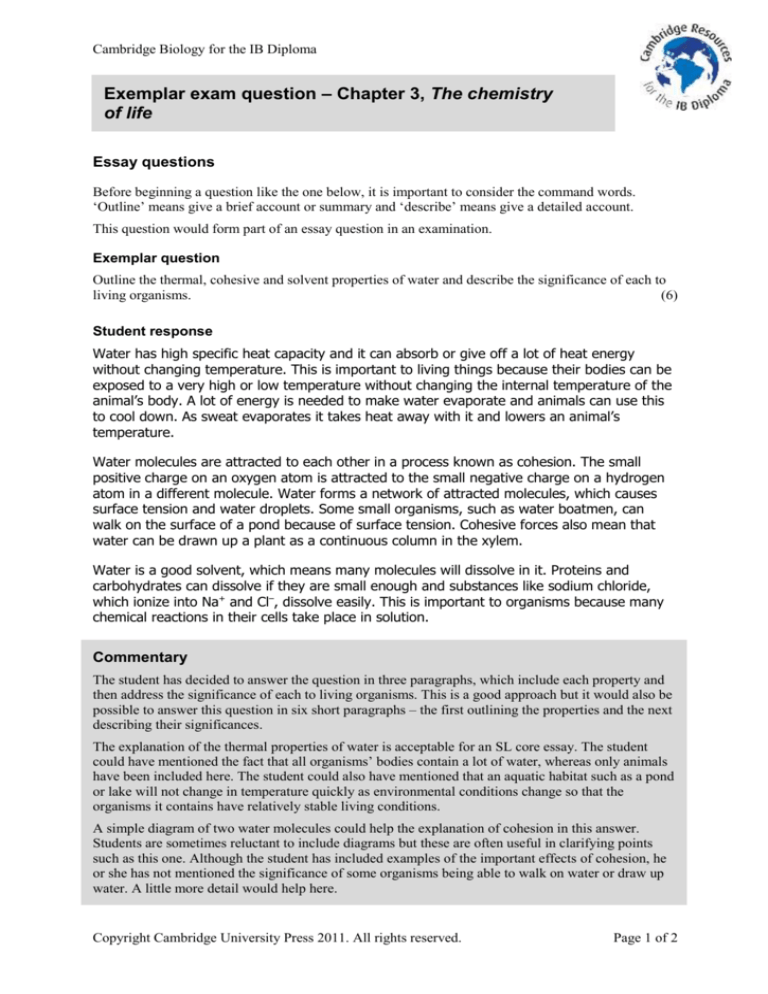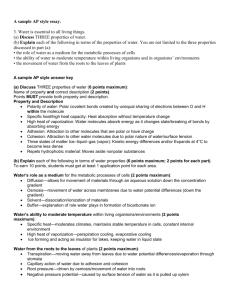
Cambridge Biology for the IB Diploma
Exemplar exam question – Chapter 3, The chemistry
of life
Essay questions
Before beginning a question like the one below, it is important to consider the command words.
‘Outline’ means give a brief account or summary and ‘describe’ means give a detailed account.
This question would form part of an essay question in an examination.
Exemplar question
Outline the thermal, cohesive and solvent properties of water and describe the significance of each to
living organisms.
(6)
Student response
Water has high specific heat capacity and it can absorb or give off a lot of heat energy
without changing temperature. This is important to living things because their bodies can be
exposed to a very high or low temperature without changing the internal temperature of the
animal’s body. A lot of energy is needed to make water evaporate and animals can use this
to cool down. As sweat evaporates it takes heat away with it and lowers an animal’s
temperature.
Water molecules are attracted to each other in a process known as cohesion. The small
positive charge on an oxygen atom is attracted to the small negative charge on a hydrogen
atom in a different molecule. Water forms a network of attracted molecules, which causes
surface tension and water droplets. Some small organisms, such as water boatmen, can
walk on the surface of a pond because of surface tension. Cohesive forces also mean that
water can be drawn up a plant as a continuous column in the xylem.
Water is a good solvent, which means many molecules will dissolve in it. Proteins and
carbohydrates can dissolve if they are small enough and substances like sodium chloride,
which ionize into Na+ and Cl–, dissolve easily. This is important to organisms because many
chemical reactions in their cells take place in solution.
Commentary
The student has decided to answer the question in three paragraphs, which include each property and
then address the significance of each to living organisms. This is a good approach but it would also be
possible to answer this question in six short paragraphs – the first outlining the properties and the next
describing their significances.
The explanation of the thermal properties of water is acceptable for an SL core essay. The student
could have mentioned the fact that all organisms’ bodies contain a lot of water, whereas only animals
have been included here. The student could also have mentioned that an aquatic habitat such as a pond
or lake will not change in temperature quickly as environmental conditions change so that the
organisms it contains have relatively stable living conditions.
A simple diagram of two water molecules could help the explanation of cohesion in this answer.
Students are sometimes reluctant to include diagrams but these are often useful in clarifying points
such as this one. Although the student has included examples of the important effects of cohesion, he
or she has not mentioned the significance of some organisms being able to walk on water or draw up
water. A little more detail would help here.
Copyright Cambridge University Press 2011. All rights reserved.
Page 1 of 2
Cambridge Biology for the IB Diploma
The final paragraph contains key points but the student has not used the word ‘polar’, which would
have helped the explanation. Here the student has indicated why solvent properties are significant to
living organisms, although an example of a reaction would have been helpful.
Marks awarded for any of the following points:
Water has a high specific heat capacity; enables organisms to maintain body temperatures; sweating
or other suitable example given.
Water has cohesive properties that result in surface tension; enables some organisms to live on water
surfaces; the importance of cohesion to transpiration.
Water is a good solvent because of its polar properties; enables many molecules to dissolve in it;
many chemical reactions occur in an aqueous environment.
Total marks awarded: 5 – the student has missed out on 1 mark for not including some details
Copyright Cambridge University Press 2011. All rights reserved.
Page 2 of 2









